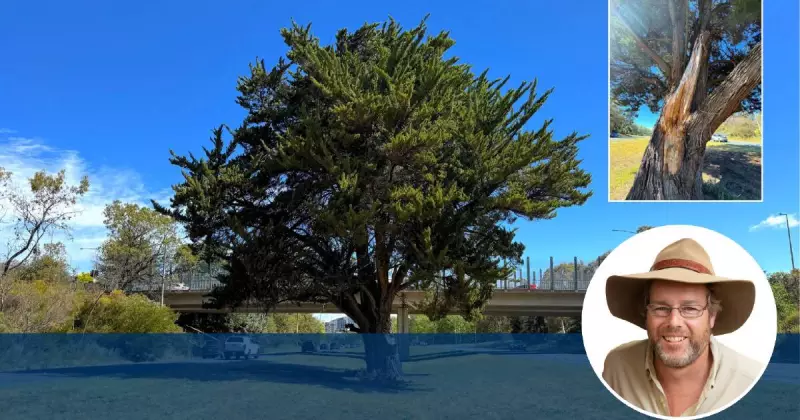
A century-old conifer that has stood proudly between the north and south lanes of Yarra Glen for decades now faces removal to make way for Stage 2B of Canberra's light rail network, according to draft environmental impact statements.
The distinctive tree, located near the Carruthers Street overpass, holds significant historical value and personal memories for many Canberrans. Recent assessments describe the conifer as being in "fair condition" but showing "some rot in the trunk", leading to its proposed removal to accommodate the new rail tracks.
A Living Link to Canberra's Past
The tree's story begins with Canberra's soldier settlers following World War I, when returned servicemen were granted land through a government scheme designed to provide employment and develop rural areas. Much of today's Woden Valley was previously part of Yarralumla Station, a massive 40,000-acre sheep property that was subdivided for these settlement blocks.
Frances McGee, a passionate community historian from Curtin, explains that the conifer provides "a direct but little-known link to Canberra's pastoral past". "Now nearly 100 years old, it connects us to the soldier settlers who established their sheep farms in the area following World War I," she says.
The first soldier to lease one of these blocks was Frank Gifford from Braidwood, who named his property Yarra Glen after his wife Eleanor's hometown in Victoria. This name would later be given to one of Canberra's busiest roads.
The Campbell Family Legacy
In 1928, George Campbell and his wife Nancy moved onto the Yarra Glen property. George brought valuable experience from working in woollen mills and studying wool classing in Bradford, Yorkshire. According to historical records, Nancy Campbell likely planted the conifer in the late 1920s as part of a windbreak around their isolated cottage.
The Campbells raised two sons on the property over more than thirty years. Robert Campbell, before his passing, vividly recalled a town planner visiting in the early 1950s and informing his mother that their home stood in the path of a future road.
Curtis Campbell, the younger son who still lives near the tree, expresses sadness about its potential removal. "I can't go past there without thoughts of my childhood," he shares. "It was wonderful it was saved in the 1960s and it's terribly sad it faces the chop."
Unexpected Survival and Personal Connections
The tree owes its survival until now to roadworker Lance Bowler, who during the mid-1960s construction of Yarra Glen road declared: "There's absolutely no way you are cutting that tree down - that's where I park my grader and have lunch every day."
His daughter Jennifer Rigg, now living on the Central Coast, still calls it "Dad's tree" and remembers her family's early years in Canberra. "We first lived in an old bus parked under a willow tree by Yarralumla Creek in Curtin," she reveals, painting a picture of Canberra's pioneering days.
On hot days, Lance and his co-workers would shelter under the conifer for their well-earned breaks, establishing a tradition that ultimately saved the tree from destruction during the original road construction.
Preservation Efforts and Future Plans
Although the tree's removal appears likely, there's hope for preserving its legacy. Frances McGee suggests that if saving the tree isn't possible, "hopefully it can be propagated and new trees planted either side of Yarra Glen" with a plaque explaining its history.
This approach has found support from the Campbell family and appears to be gaining traction with authorities. When questioned about the tree's fate, a spokesperson for the ACT Tree Register indicated that propagation is being explored along with ceremonial plantings and a memorial plaque to honour the soldier settler families of Woden Valley.
The final Environmental Impact Statement for the light rail project is expected in 2026, which will confirm the tree's fate and detail any preservation measures.
George Campbell's Remarkable War Service
The tree's story connects to broader historical narratives, including George Campbell's military service. After serving in World War I, he enlisted in the Volunteer Defence Corps during World War II with a unique mission: guarding the Cotter Dam against potential sabotage.
Armed with a Mauser rifle he'd "souvenired" from a German officer during the previous war, Campbell and neighbour Neville Milson protected Canberra's water supply. His son Curtis remembers visiting the dam site, walking "through the tunnel at the dam and across to the powerhouse" with his father.
Nancy Campbell later revealed the rifle was so heavy that her husband joked he would have needed enemy assistance to load it. The weapon was eventually recalled by the army toward the war's end.
As Canberra continues to evolve and modernise with projects like the light rail network, this conifer represents the difficult choices between progress and preservation that face growing cities. Its potential removal highlights the importance of documenting and commemorating the layers of history that shape our urban landscapes.





